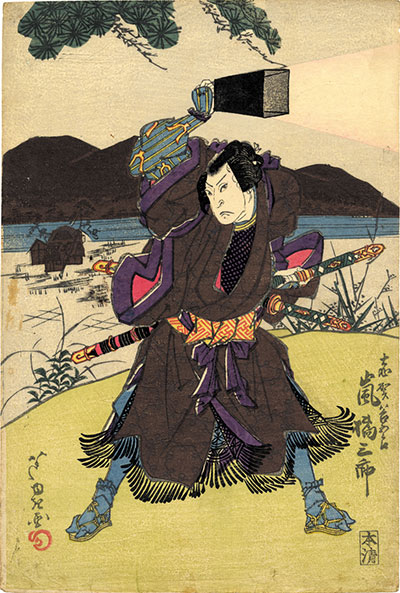Lights and shadows in ukiyo-e
September 4 (Tue), 2018 – December 2 (Sun), 2018
This museum exhibits ukiyo-e paintings produced in Osaka in the Edo period. Most of the ukiyo-e paintings made in Osaka were portraits of kabuki actors. The vivid-coloured ukiyo-e tell us how the stage was like at the time.
It is well-known that ukiyo-e influenced western art in the 19th century, especially the lack of perspective overturned the common sense of art. In ukiyo-e, even lights and shadows are expressed with simple lines in order to emphasize the kabuki actor standing firm on stage.
In this feature exhibition, we focus on lights and shadows on kabuki stage in ukiyo-e. We focus on the way of expression of lights and darkness in ukiyo-e in which shadows of people are not drawn. Enjoy the lights and shadows which is difficult to see in modern world where it’s too light even in the middle of the night.

“Aneimouto Date no Okido” by Ashiyuki
Lights that are described
Not just portraits of an actor but many of the portraits are close-ups of the model in order to have viewers concentrate on the subject actor/beautiful woman. Ukiyo-e artists, taking in the new trend, depict the model’s full/upper body attractively. It means that the model is already in the light of ‘gazing’.
In ukiyo-e, a depicted person can be clearly seen even the person is in the darkness, and the darkness is described by drawing the line of light. By drawing the lights line, the light and the shadow are distinguished, describing the darkness and invisible part clearly.
By emphasizing the light, the darkness is described.
Lights in the night
It was the time that there was no electricity to light things up. Fire such as of candles were the lights that shines the night. But the candles were used only on special occasions because they were expensive.
Usually the andon, traditional lamp in Japan, was used for the night and variety of types of andon were drawn in ukiyo-e. Andon provided the light by burning wick with oil. Candles were a lot brighter than andon so they were used when going out at night within gando (lamp) or chochin (paper lanterns).
In kabuki plays sashigane was sometimes used to describe ‘human soul’ that appeared in the dark in the middle of night. Sashigane is a thin bamboo rod with shochu-dipped colth at the end, set fire. (Shochu is a traditional Japanese distilled spirit.) Floating light in the darkness of a theater must have lighted kabuki actors mysteriously.
Black is invisible
In kabuki plays, there is a convention that ‘black is invisible’ so a person who wears all black, head to toe, such as ‘kurogo’ who supports the performance, is supposed to be invisible and not in the part of the play.
There is also a performance called ‘danmari’, it is a pantomime, kabuki actors move slowly and silently as if they are in the dark. In many cases ‘danmari’ performance has the role to introduce the actors, so they have to be seen by the audience. It means that the actors on stage move as if they are in the dark, but the darkness (black) is invisible.
Although shadow is described as black in ukiyo-e, the actors’ figures are clearly visible even in the night scene. This is another example of ‘black is invisible’.
Black as a clolour
In ukiyo-e, sumi ink is used for black colour. At the time that ukiyo-e was printed only by using sumi ink and other colours were put on with brushes afterwards, there was a type of artwork called ‘urushi-e’. To draw ‘urushi-e’, ink with more nikawa, an animal-based glue, was used in order to gain more polish as if it was painted with urushi (lacquer). By using ‘tsuya-suri’ (polish-printing) technique, it was possible to make patterns that shine on black kimono.